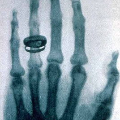Medical image segmentation is considered as the basic step for medical image analysis and surgical intervention. And many previous works attempted to incorporate shape priors for designing segmentation models, which is beneficial to attain finer masks with anatomical shape information. Here in our work, we detailedly discuss three types of segmentation models with shape priors, which consist of atlas-based models, statistical-based models and UNet-based models. On the ground that the former two kinds of methods show a poor generalization ability, UNet-based models have dominated the field of medical image segmentation in recent years. However, existing UNet-based models tend to employ implicit shape priors, which do not have a good interpretability and generalization ability on different organs with distinctive shapes. Thus, we proposed a novel shape prior module (SPM), which could explicitly introduce shape priors to promote the segmentation performance of UNet-based models. To evaluate the effectiveness of SPM, we conduct experiments on three challenging public datasets. And our proposed model achieves state-of-the-art performance. Furthermore, SPM shows an outstanding generalization ability on different classic convolution-neural-networks (CNNs) and recent Transformer-based backbones, which can serve as a plug-and-play structure for the segmentation task of different datasets.
翻译:医学图像分割被认为是医学图像分析和手术干预的基本步骤。许多以前的工作尝试引入形状先验来设计分段模型,这有利于获得具有解剖形状信息的更好的蒙版。在我们的工作中,我们详细讨论了三种具有形状先验的分段模型,包括基于atlas的模型、基于统计的模型和基于UNet的模型。鉴于前两种方法显示了较差的泛化能力,基于UNet的模型在最近几年主导了医学图像分割领域。然而,现有的基于UNet的模型往往采用隐式形状先验,这在具有不同形状的不同器官上缺乏很好的可解释性和泛化能力。因此,我们提出了一种新的形状先验模块(SPM),它可以明确地引入形状先验来促进基于UNet的模型的分割性能。为了评估SPM的有效性,我们在三个具有挑战性的公开数据集上进行了实验。我们提出的模型实现了最先进的性能。此外,SPM还展现出在不同的经典卷积神经网络(CNN)和最近的基于Transformer的骨干网络上出色的泛化能力,可以作为不同数据集分割任务的简单插入式结构。


